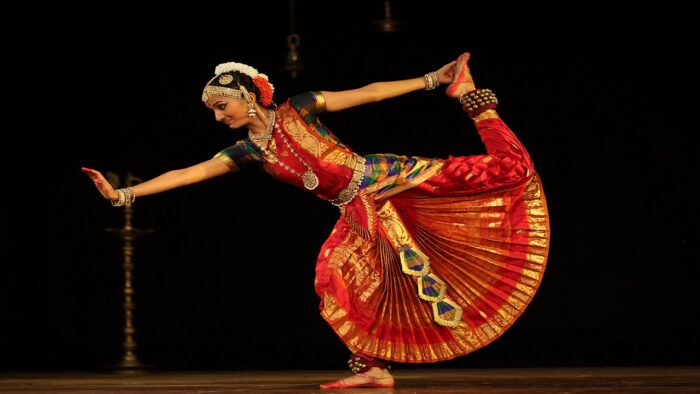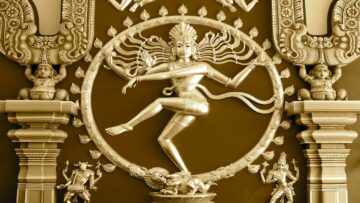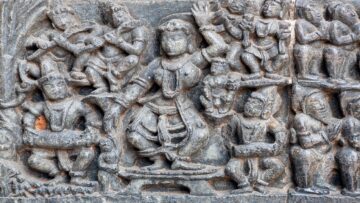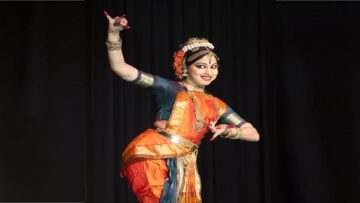I. Introduction
Drama touches upon all aspects of human activity – poetry, musical instruments, singing, rhythm, dance, gestures, dancing, ornaments, costumes, acting and literature. It depicts different groups in society with their peculiar manners, style of dress and speech. As art mirrors reality, drama was called upon to depict society in all its variety in a true albeit artistic representation. It draws its material from the ways of the world, reflecting the norms and aspirations of society. The staging of a play also called upon the skills of almost every group of artisans such as carpenters, weavers, musical instrument makers, ornament makers and others.
Our ancient dramatic tradition offers a window into the society of those times. Alongside vast strides in technology in today’s world, we can still relate to the emotional content of the performing arts from our hoary past.
II. Classical Performance as a Yajña
Ancient Indian culture considered all dedicated activity as a sacrificial offering, a yajña. This underlying concept is found repeated in many important contexts of life as well as artistic endeavour. A stage presentation of dance and drama was regarded as an offering to the gods, a celebration, as well as spiritual nourishment for the audience. The aesthetic theory of rasa gives an underlying unity to all the fine arts. Drama utilizes all the arts and sciences known to society and involves a large number of artisans to come together for a grand stage presentation.
Prior to every performance, a worship ritual known as the Pūrvarańga was conducted. Begun backstage, the rituals continued on the stage too, the entire troupe participating in it along with the musicians and assistants. Once the auditorium was constructed, the images of the deities were to be duly installed in positions specified in the Nāṭyaśāstra on the stage, in the passageways and even behind the curtain. Offerings of lamps, flowers, cloth, sandal paste, garlands, incense, fruits, leaves, meats, sweetmeats and rice cooked with ghee, jaggery or molasses were made with the chanting of mantras. The purpose was to consecrate the performance to delight the gods for the well-being of society and to invoke their blessings for its successful completion. Bharata states that this helps the dancers and actors achieve a state of calm that will help them perform to the best of their ability.
From the 3rd Chapter in Nāṭyaśāstra–
अनेनैवविधानेनयथास्थानंयथाविधि।
वर्णरूपान्विताःसर्वादेवताःसंनिवेशयेत्॥32॥
anenaivavidhānenayathāsthānaṃyathāvidhi|
varņarūpānvitāḥsarvādevataḥsaṃniveśayet || 32
स्थानेस्थानेयथान्यायंविनिवेश्यतुदेवताः।
प्रकुर्वीतततस्तासांपूजनंतु यथार्हतः॥33॥
sthānesthāneyathānyāyaṃviniveśyatudevatāḥ |
prakurvītatatastāsāṃpūjanaṃtuyathārhataḥ || 33
दैवतेभ्यस्तुदातव्यंसितमाल्यानुलेपनम्।
वह्निगन्धर्वसूर्येभ्योरक्तमाल्यानुलेपनम्॥34॥
devatebhyastudātavyaṃsitamālyānulepanam |
vahnigandharvasūryebhyoraktamālyānulepanam || 34
गन्धंमाल्यं च धूपं च यथावदनुपूर्वशः।
दत्वाततःप्रकुर्वीतबलिंपूजां यथाविधि॥35॥
gandhaṃmālyaṃ ca dhūpaṃ ca yathāvadanupūrvaśaḥ|
datvātataḥprakurvītabaliṃpūjāṃyathāvidhi || 35
“In this (aforesaid) arrangement the images of deities are to be installed with corresponding form and colour (32). After placing the gods in the proper positions their worship must be performed as befitting (33). The gods are to be offered white garlands and unguents; Agni, Gandharvas and Surya are to be given red cloth, garlands and unguents (34). Then incense, sandal, lamps as per procedure after which food offerings should be made (35).”
The worship rituals with dance to sanctify the stage were sometimes called the Nāndī, after the invocatory song or verse. The term ‘Nāndī’ implies that it was meant to delight the gods as well as people. This was performed by a group of skilled dancers who went around the stage, pausing at each of the eight quarters to offer worship to the respective deity of that quarter with the corresponding mudras, motifs, poses and stances, offering flowers and worship through abhinaya. The stage or rańgabhumi was regarded as the yajñabhūmi and this piece was to consecrate the stage, propitiate the deities of the various directions to protect the space to ensure smooth and successful completion. The Nāndī ritual could employ intricate karaņas of nŗtta or pure dance which were not only wonderful to view but also sacred in their significance, gaining adŗṣṭa-phala. This was accompanied by rich instrumental music and perhaps chanting and singing of ślokas. A simple invocatory ritual was called śuddhaPūrvarańga while an elaborate one was called ChitraPūrvarańga. The music and elaborate dancing indicated to the audience that the play was about to begin and helped them settle down in anticipation.
Improper worship or skipping the propitiation to the gods was looked down upon severely.
“Fire fanned by the breeze does not burn as fiercely as a performance without proper procedure would immediately!” NāṭyaśāstraIII. 102.
Senior Bharatanatyam Guru based in the U.S., Prakruti Prativadi writes that when it is explicit that BharataNatyam has dhārmic origins as its avowed purpose, the performance is compared to a yajña and has to begin only after due propitiation of Hindu divinities, it is improper to use the art form to convey frivolous issues bound by contemporary time and space, or themes founded on the performer’s ego or even for the purpose of proselytization. To use Hindu motifs against the dhārmic ethos is unwarranted cultural appropriation.
“The dancer must sprinkle sanctified water on each limb to purify the body and must partake of the pūjā and homa with the utmost sraddhā and bhakti in order to bring his or her mind into a state of sattva…capable of a performance with bhāva and rasa… These performances are a few hours long and in some classical dances like Kathakali and Yakshagana, last through the night, so the dancer needs to muster tremendous energy, enthusiasm and concentration.” (p 300)
“Thus we see that Christian doctrine is diametrically opposite to Vedic metaphysics and is not capable of embodying the knowledge of the Vedas. The Vedas hold that we (including animals) are divine and that Brahman resides in all of us; we can unite with and become Brahman not by blind belief but by our own sādhanā and effort. Thus, inclusion of any Christian theme, symbol or character in Bharatanatyam is syncretic in character and antithetical to the nature of Bharatanatyam.” (p 307)
III. The Play – Structure of a Nāṭaka
The play began with the director, known as the Sūtradhāra, reciting the invocatory verse or Nāndī, often written by the playwright himself and then announcing the title of the play as well as the name of the playwright. It is very likely that he acknowledged the place, occasion and sponsors of the event, although these are not required to be recorded in the manuscripts of the plays. To help the audience understand the context in which the play opened, he also announced the names of the characters and described the scene that was about to begin. This was usually done through a small exchange of dialogue between the Sūtradhāra and his assistant or any minor character in the play. This constituted the prologue, a small scene before the main play began. After this the first act opened with the major characters participating in it.
An act was generally understood to take place in a single location and timeframe, with some major event defining it. Every act was preceded by a short interlude in which minor characters conveyed the events of the story to take the plot forward. By using slang, local dialects and comic relief, the interludes helped to enliven the action and to convey events that were difficult to dramatize, such as war, travel or passage of time. The Nāṭaka, which was the most elaborate and refined form of drama had up to seven main Acts. The play was required to have a wide variety of characters with their movements, costume and language reflecting their diverse positions in society.
The Nāṭyaśāstra is very clear that good drama should have a well-defined plot that unfolds through the hero stating his avowed goal, the development of obstacles to that goal, his overcoming all the obstacles and then the ultimate triumph. Whereas in real life, an enterprise may or may not succeed, drama should end on a positive note of victory. Upon achieving the goal, there is rejoicing and one of the actors recites the Bharatavākyam, a verse of benediction for all – the actors, musicians, the king and everybody in the audience. Thus the people disperse after a performance with a sense of collective well-being.
IV. Music and Dance in Drama
The play is composed of dialogues, poems and a few stage directions by the playwright. Much is left to the creativity of the stage director in terms of action and choreography. Sańgīta, comprising of song, instrumental music and dance, was the mainstay of the performance. People from all walks of life gathered by the light of oil lamps after the day’s work was done to enjoy a performance that could well go on all night, showcasing good story, gripping plot, learned dialogue, colourful costumes, but most of all, skilled dancing and music to match the mood.Dialogues were delivered with trained voice, sometimes stylized and sometimes realistic, and the verses were sung or recited, often with music and accompanied by elaborate abhinaya. The natural beauty of the surroundings, such as forests, trees, lakes, rivers, waterfalls, mountains, creepers, flowers, birds and the bees were very popular in drama and evoked through poetry and abhinaya. Pure dance movements, set to the rhythm, known as nŗtta, was prized to add ornamentation and elegance to the drama. Graceful movements called lāsya was especially suited to ladies and depicted in Sŗńgāra, while the more vigorous, forceful movements constituting Tāņḍava were used in depicting scenes of combat and battle.
The music for each part of the programme was also well-defined. The tunes, rhythm and tempo of the music based on Rāga, Tāla and Layaas as well as the choice of musical instruments were selected according to the mood of the scene, as suitable to the rasa. Further, songs and music for the start of the play, interludes, entry of characters, climax and culmination etc., were all well-defined and popular and not necessarily part of the script of any specific play. Pure dance pieces similar to aḍavus and jatis were performed by the characters during entry and during the play, accompanied by music and song. In effect, the play was similar to what we understand today as a dance-drama, with elements of realistic theatre being incorporated.
The enactment through bodily movements, āńgikaabhinaya, was basically of two kinds – lokadharmi, which consisted of more realistic movements that were easier to understand, and nāṭyadharmi, which were stylized with coded gestures. While the nāṭyadharmi movements added elegance and grace, conveying the meaning of the literature through suggestion, they also included mudras and hastas that stood for specific meaning. For example, while the mime may be clear that a bird is to be understood, specific gestures would represent a dove, a parrot or a peacock. Thus the more accustomed a spectator is with the language of dance, the more he or she can enjoy the performance.
V. Ten types of plays
The Nāṭyaśāstra as well as later texts such as the Daśarūpaka and Sāhityadarpaņa describe ten types of plays in Sanskrit, indicating its versatility and use among the common people. The plays are classified according to duration of performance, theme, manner of presentation, language employed and type of characters. It is clear that drama was enjoyed by all classes of people and that Sanskrit was spoken or at least understood by the majority. The Nāṭaka described above, was only one of the ten types of Rūpaka or DŗśyaKāvya (Kāvya to be viewed) and represents the most sophisticated of them, employing the fine arts at their best. While some types of plays were suitable to present at temple festivals or royal households, others were meant for the marketplace. A brief account of the other nine types of drama is as follows.
The Prakaraņa with five to ten acts was very similar in style to the Nāṭaka except that it was a work of fiction created by the author and not based on the Purāņas. The seed of the plot was original, the hero belonging to normal society and was not a well-established Puranic character. Typically, the story revolved around the deeds of a Brahmin, merchant or official of the kingdom, i.e., the general public and was not a royal.
The Samavakāra dealt with devas and asuras. It had three acts of long duration with a large number of characters, plenty of intrigue, deceit, calamities and fighting. It would depict three kinds of love – that arising out of duty or obedience, from material gain or profit and that arising from passion. It was a high-energy drama with much confusion and excitement, depicting extremes in joy and sorrow.
The Īhāmŗga had divine heroes and war on account of the love of a woman. Duels were depicted and at the point where one would kill the other, the fighting was interrupted due to some event and the killing averted. The Dima was a fantastic presentation with sixteen heroes and all the rasas portrayed except śrńgāra and hāsya. It was an action-packed play with occurrences such as earthquakes, falling meteors, eclipse of the sun and moon or battles with dreadful weapons, showing plenty of deceit and jugglery. The characters were frequently violent and ranged from humans, gods and asuras to yakṣas, zombies and nāgas.
The Vyāyoga was a short play with few acts, the hero being a noble, dignified human being, not divine. It had very few female characters and was expected to develop the plot briskly with suspense, conflicts, battles, wit and humour. The Ańka was a one-act play with a tragic theme, depicting great weeping and wailing of women, lamentation, soliloquys, despairing speeches and distressing movements. It was based on pathos, Karuņa rasa.
The Prahasana, Vīthī and Bhāņa were predominantly humorous with a touch of satire and serious observations on the hypocrisies in society. They were of a single act, sometimes with just one actor delivering his lines with mimicry and mime, or sometimes with a couple of jesters in conversation. Much like the stand-up comedies of today, they were peppered with wry humour and ribald jokes. The Bhāņa in particular, was expected to use vulgar language with obscene innuendo, much to the delight of the audience.
Over time, the Sanskrit texts on nāṭya indicate a shift in interest from the long plays to shorter presentations known as Uparūpaka, which had dance predominantly with song and music. These were meant for the audience to enjoy and were mostly graceful and elegant with Lāsya movements. The Hallīśa in particular was based on Sŗńgāra rasa and had a group of ladies dancing in a circle.
VI. Vestiges of Sanskrit Theatre in Regional Styles
The structure and form of the Sanskrit drama must surely be replicated in regional languages as time wore on or even simultaneously, to varying extents. Early black-and-white cinema in the early 1900ś in India began with a Sūtradhāra appearing on the screen! In folk and classical theatre such as Yakṣagāna, Kathakali, Kūḍiyāṭṭam, Kūthu, BhāgavataMela and Chau, we can see similarities to the features discussed in the Nāṭyaśāstra. The Purāņic themes, the entry and introduction of the characters with drums and dance, the interspersion of dialogue with song and dance, the development of rasa, the culmination with a benediction, have all survived the duration of millennia. The Nāṭyaśāstra shows deep understanding of the psychology of the viewer, the maturity of technique and the lofty purpose of Nāṭya. Dating to several centuries before the Common Era, it represents a mature art form that reflects the cultural mores of Indian civilization.
Bibliography
Dwivedi, Parasnath Ed. (1996) Nāṭyaśāstra of Bharatamuni with Abhinavabhārati, Part I – Chapters1-5. Varanasi. Sampoornan and Sanskrit University.
Prativadi, Prakruti (2019) “The Bharatanatyam yajña”. Pp 287 – 311. In Narayanan, Sharda (Ed.) Studies in Tamil Civilization: Fount of Culture, Proceedings of Swadeshi Indology ConferenceĪI. Chennai. Infinity Foundation India.
Pushpendra Kumar (Ed.) (2019) Nāṭyaśāstra of Bharatamuni, with English Translation. Vol I. Delhi. New Bharatiya Book Corporation.
Ramachandra Aiyar, T.K. A Short History of Sanskrit Literature. R.S. Vadhyar& Sons. Palghat. 2021.
Rangacharya, Adya. Nāṭyaśāstra of Bharata – English Translation. Munshiram Manoharlal, Delhi.
Vatsyayan, Kapila (1968) Classical Indian Dance in Literature and the Arts. Sangeet Natak Academy. New Delhi.
Feature Image Credit: istockphoto.com
Disclaimer: The opinions expressed in this article belong to the author. Indic Today is neither responsible nor liable for the accuracy, completeness, suitability, or validity of any information in the article.










